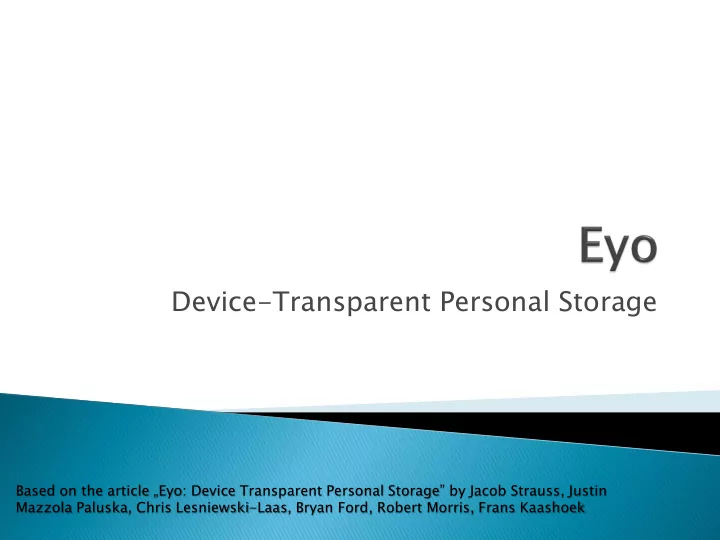

Device-Transparent Personal Storage Based on the article „ Eyo: Device Transparent Personal Storage ” by Jacob Strauss, Justin Mazzola Paluska, Chris Lesniewski-Laas, Bryan Ford, Robert Morris, Frans Kaashoek
Eyo’s assumptions and API Main features ◦ Placement rules ◦ Version histories ◦ Conflicts management Continuous synchronization Implementation Evaluation of the system
Single view of entire data collection from every user’s (personal) device A user can think in terms of „file X” rather than ”file X on device Y” More than location transparency in traditional distributed systems (why?)
Mobile devices can’t store entire data collection Concurrent updates from disconne onnected ted devices result in conflicts
Created by researchers from: ◦ MIT ◦ Yale University ◦ Quanta Research Cambridge New personal storage system ◦ Device-transparent ◦ Design and storage model motivated by disconnected devices ◦ Supports limited-storage devices ◦ Peer-to-peer communication
Separate te me metadata a fr from m conten ent Metadat ata a is small enough h to replicate ate on every device Updates of objects content are rare Updates of metadata, inserting and deleting objects are common Metadata for common data types are specified ◦ e.g. ID3, EXIF, email headers
User’s data stored as a flat set of versioned objects Each object is a directed acyclic graph of its versions Each version has assigned metadata, content and list with IDs of its ancestors
Application retrieves objects via queries on metadata: ◦ lookup() – single search query ◦ addWatch() – persistent query (conflicts resolution) Eyo uses subset of SQL ◦ Efficient to execute ◦ Limited in expressivness ◦ Unsupported query: 10 most viewed pictures ◦ Supported: pictures viewed more than 100 times
Determines which object has highest priority for storage Important on devices with limited storage Eyo stores rules as objects without content ◦ Rules are synchronized like other metadata Synchronization ensures that at least one copy of content is stored even if no placement rule matches
Application is responsible for handling concurrent updates using Eyo’s API Version graphs ◦ indicate most recent common ancestor Event notifications
Reduces update conflicts by propagating changes as fast as network allows Synchronization start right after update ◦ pending updates structure Met etadata adata synchronizati nchronization on ◦ device-transparency effect Conten ent sync ynchr hroni onization zation
Metadata is usually small and updates must be passed as fast as possible Eyo groups recent updates into generation, identified by device ID and generation counter on that device In the personal group of n devices, each device stores vector of n elements with information about latest generations received from other devices
Versi ersions ons gr graph ph truncatio uncation ◦ Eyo knows when generation objects have been seen by all devices (checking generation vectors) ◦ Eyo can combine contents of those generation objects into single archive and truncate the version history Adding ing and d removin ving g devi vices es ◦ new device sends getGenerations() request with missing elements and gets complete copy of all generations
Device keeps a sorted list of content object to fetch Eyo uses the global distribution of metadata to track where is the content Metadata flags: ◦ hold – device wants to store the content ◦ purge – device wants to delete the content
Eyo daemo mon ◦ written in Python ◦ libraries for C applications ◦ runs on each participating device ◦ handles external communication ◦ runs on Linux and Mac OS X ◦ connects to other devices via UIA SQLite te (metada data ta storage ge) Local fi file systems ems (cont ntent ent storage) ge) XML-RPC PC UIA (Unmanaged Internet Architecture) – global connectivity architecture for mobile devices
Lack of information in the paper Metadata-everywhere model If there is no placement rules then bandwith is used only for transferring metadata and protocol overhead (XML-RPC)
Having disconnected devices result in increasing metadata size Version graphs cannot be truncated
Cimbiosys ◦ supports placement rules Perspective ◦ supports placement rules ◦ disconnected devices cannot continue to see complete collection Coda ◦ disconnected operations ◦ consistency algorithms for file systems
Eyo separates metadata from content Metadata-everywhere model Peer-to-peer communication Continuous synchronization Supports storage-limited mobile devices ◦ placement rules Supports disconnected devices ◦ concurrent updates resolutions Assumes many things about applications
Recommend
More recommend